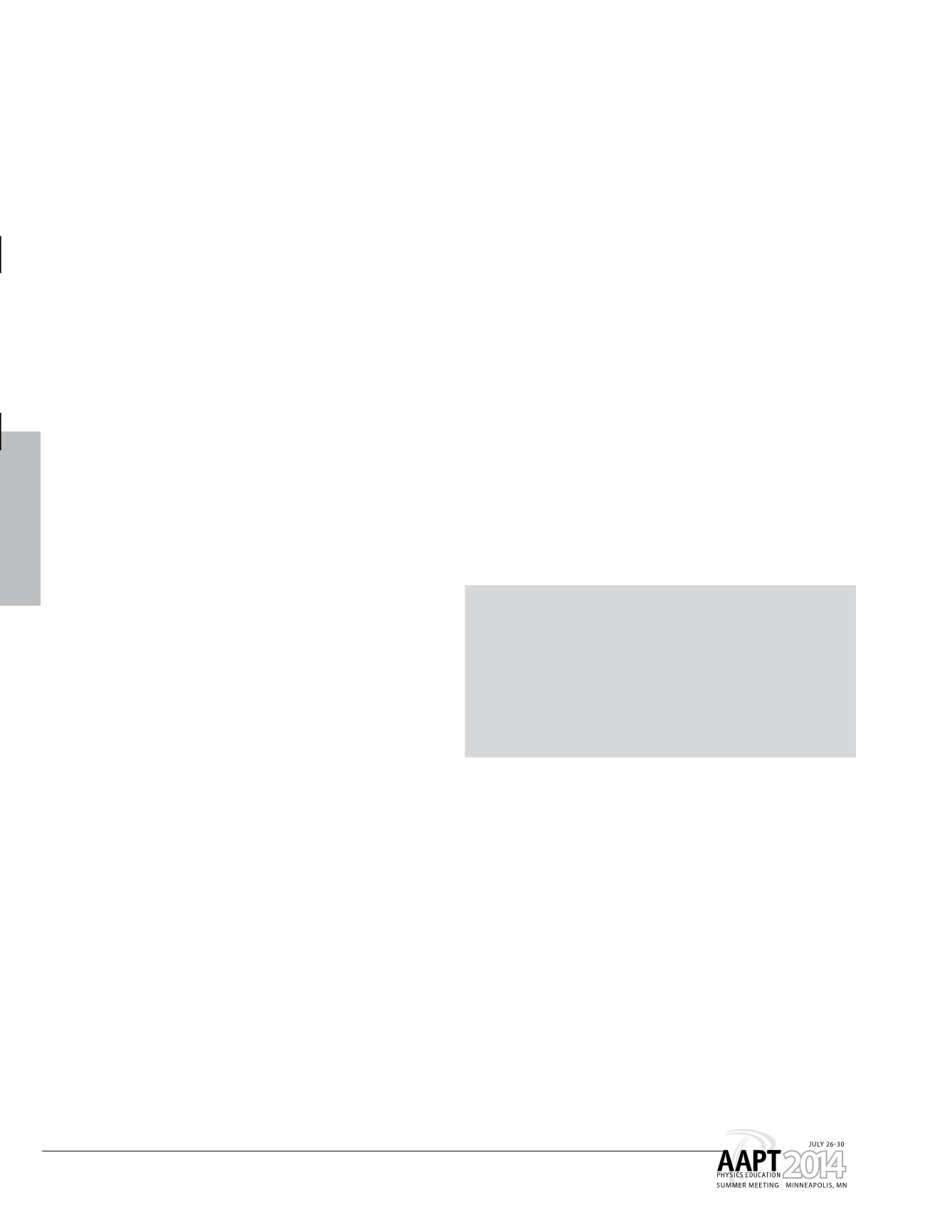
98
Tuesday morning
DG10:
9:30-9:40 a.m. Measuring the Effectiveness of Collab-
orative Group Exams
Contributed – Joss Ives, University of British Columbia, Vancouver, BC V6T
1Z1;
I will report on the results of a study designed to measure the effectiveness
of an instructional strategy known as 2-stage exams or collaborative group
exams. This exam format first has the students take the exam individually.
Once all the students have handed in their individual exams, they organize
into collaborative groups of three or four and take the same exam again
with only a single copy of the exam being given to each group. Different
versions of the group exam featured different subsets of the questions from
the individual exam. Questions isomorphic to the exam questions will be
administered on the end-of-course diagnostic and comparisons, using the
relevant isomorphic question, will be made between the students that saw a
given question on the group exam and those that did not.
DG11:
9:40-9:50 a.m. Influence of Previous Subject Experience
on Interactions During Peer Instruction
Contributed – Judy Vondruska, South Dakota State University, Brookings, SD
57007;
In an analysis of correct/incorrect responses during peer instruction in an
introductory survey of physics course for undergraduates, students with
previous subject experience were found to have a higher correct response
rate before and after discussion than all other partner groupings. If a
student with previous subject experience was paired with a student with no
previous subject experience, there was an increase in correct response rate
after discussion but no lasting benefit was found on end-of-unit exams. If a
discussion pair consisted of two students with no previous subject experi-
ence, correct response rates were low and remained low after discussion.
The nature of the pairing appears to influence correct response rates to
questions posed during peer instruction and also influences student’s at-
titudes about the course and the value of peer instruction.
Session DH: Electronic Lab
Notebooks
Location: Tate Lab 133
Sponsor: Committee on Laboratories
Co-Sponsor: Committee on Educational Technologies
Date: Tuesday, July 29
Time: 8–9:10 a.m.
Presider: Ben Zwickl
DH01:
8-8:30 a.m. Electronic Lab Notebooks, Jet Packs, and
Flying Cars
Invited – Edward Price, CSU San Marcos, 333 S. Twin Oaks Valley Road,
San Marcos, CA 92096;
Electronic laboratory notebooks hold the promise of integrating computer-
based data collection and analysis, written lab reports, digital archiving/
sharing, and collaboration. Yet the reality often lags behind this promise.
By adopting a broad perspective on educational technology, this talk will
identify some of the conditions and features necessary for electronic lab
notebooks to fulfill their promise and see wider usage. Lessons will be
drawn from experience with TabletPC-based lab notebooks, photo-sharing
websites, screencasts, and other educational uses of technology.
DH02:
8:30-8:40 a.m. Experiences with Lab Notebooks in
Blackboard 9.1 – The Good, the Bad, and the Ugly
Contributed– David R. Klassen, Rowan University, Department Physics &
Astronomy, Glassboro, NJ 08028;
Lab notebooks have been a mainstay in my introductory physics courses
for quite some time now. In the spring of 2012 I transitioned from having
each student keep their own physical notebook to each group of students
DG06:
8:50-9 a.m. Exam Preparation Using Narrated Animated
Solutions
Contributed – Noah Schroeder, University of Illinois, Urbana, IL 61801;
Tim Stelzer, Gary Gladding, University of Illinois
Worked examples are common tools used to give students information
about solution procedures, often as feedback after students fail to suc-
cessfully complete a problem. Narrated animated problem solutions were
created and implemented in several different contexts. Several clinical
experiments were conducted to determine successful methods of imple-
mentation. Materials used were implemented using smartPhysics. Results
will be shown.
DG07:
9-9:10 a.m. Mastery Learning in an Electromagnetism
Course
Contributed– Brianne N. Gutmann, University of Illinois at Urbana-Cham-
paign, Urbana, IL 61801;
Gary Gladding, Tim Steltzer, Noah Schroeder, University of Illinois at Ur-
bana- Champaign
In an attempt to see the effect of mastery learning in physics, we created
materials for an introductory electromagnetism course that tested super-
position of electric fields, followed by electric potential, two subjects that
have notoriously been difficult for our students. We presented these sets
of questions in mastery mode, as a single presentation, or not at all, and
compared performance on a written assessment. The effect of these tools,
especially the mechanism for delivery (mastery or not), will be discussed
and results will be shown.
DG08:
9:10-9:20 a.m. Design and Development of Targeted
Mastery Exercises for Introductory Physics
Contributed – Gary Gladding, University of Illinois at Urbana-Champaign,
Urbana, IL 61801;
Tim Stelzer, Noah Schroeder, Brianne Gutmann, University of Illinois at
Urbana-Champaign
We have developed and tested prototype online exercises targeted for
specific learning objectives in introductory physics. These exercises are
delivered in a “mastery” mode. That is, students are given a set of ques-
tions; if they do not answer correctly the minimum number required for
mastery, they are given access to narrated animated solutions to these
questions after which they are presented with a new set of questions. This
process continues until the students achieve mastery. We will discuss the
design of these questions and their solutions and present preliminary data
on student learning from these exercises.
DG09:
9:20-9:30 a.m. Are We Reaching Limits of Practice
Exam?
Contributed – Witat Fakcharoenphol, University of Illinois at Urbana-Cham-
paign, Champaign, IL 61820;
Practice exams are commonly used by students to prepare for exams. Our
first experiment showed that practice exams are useful but also limited
(Fakcharoenphol 2011).
1
A series of experiments on practice exams was
conducted to examine the effect of various feedback (Fakcharonephol
2014) and distributing practice exams throughout the semester. A followup
experiment was conducted to understand the optimal conditions for help-
ing students learn from practice exams.
W. Fakcharoenphol, E. Potter and T. Stelzer, “What students learn when studying
physics practice exam problems,”
Phys. Rev. ST Phys. Educ. Res
.
7
, 010107 (2011). W.
Fakcharoenphol and T. Stelzer, “Physics exam preparation: A comparison of three
methods,”
Phys. Rev. ST Phys. Educ. Res.
(in process)


